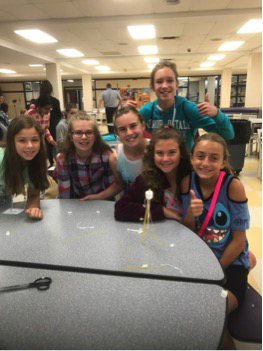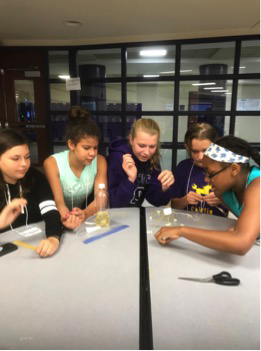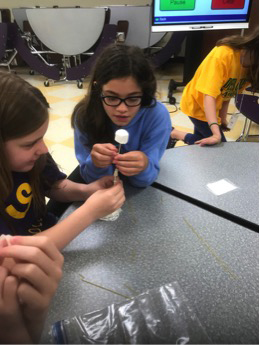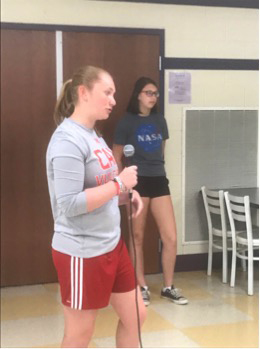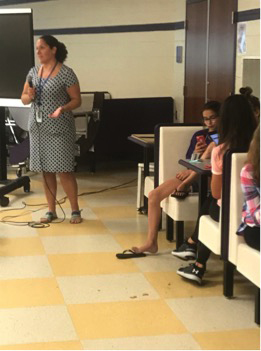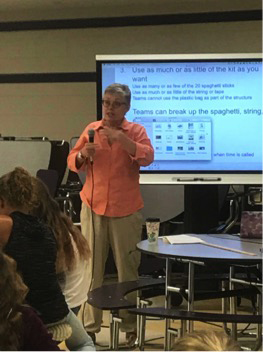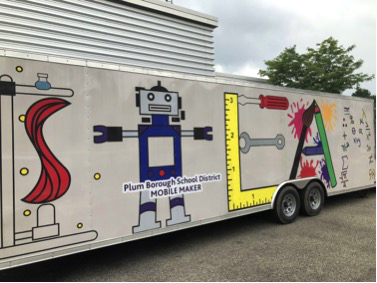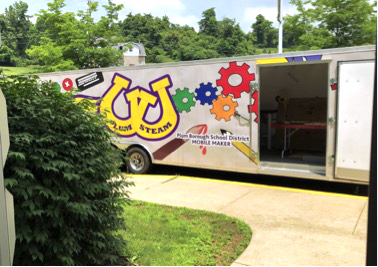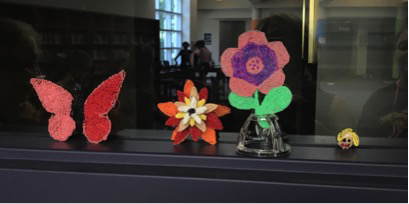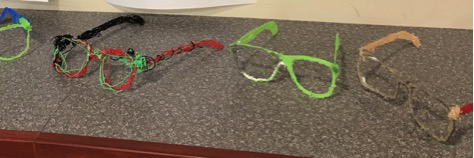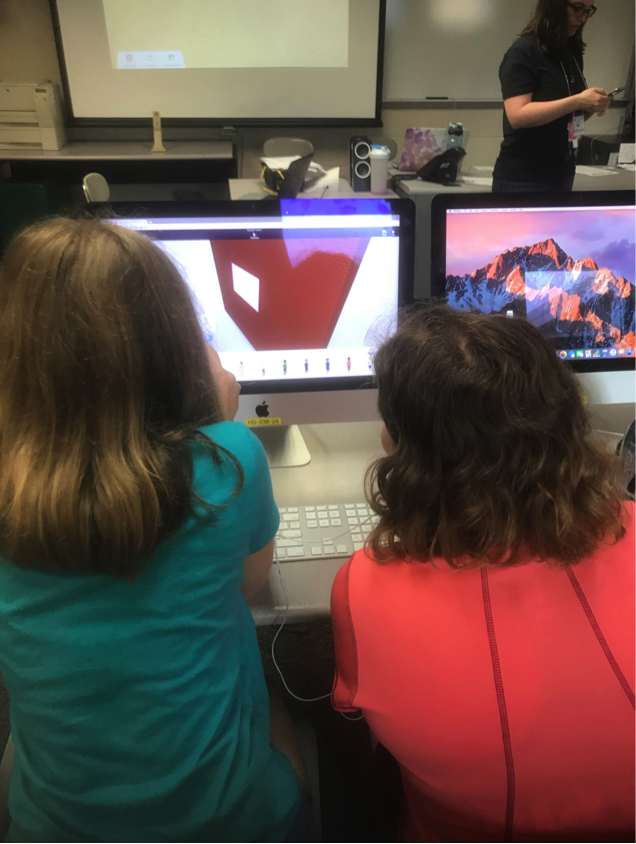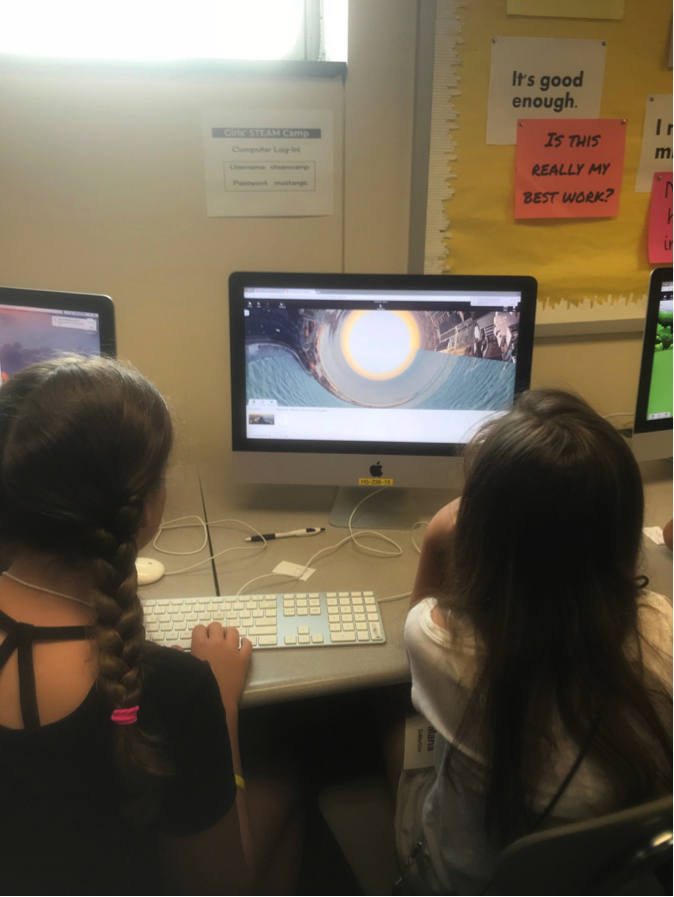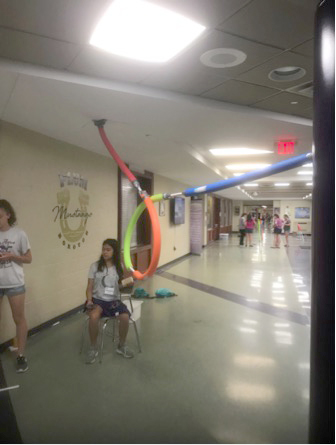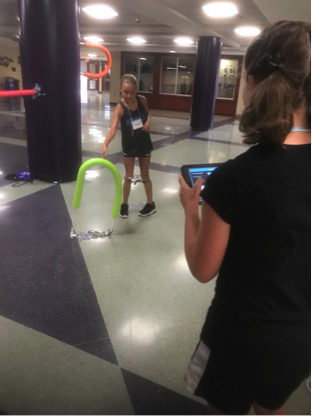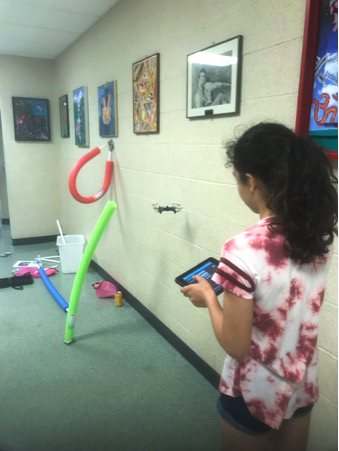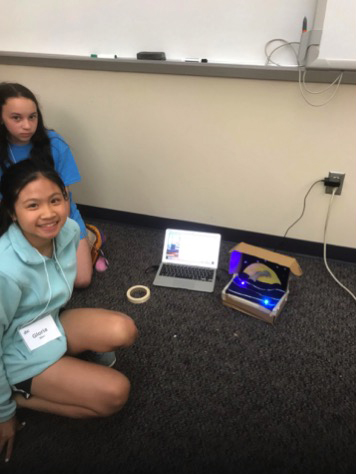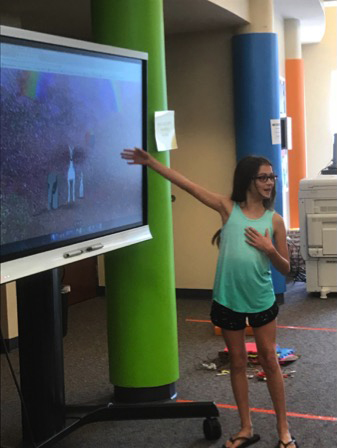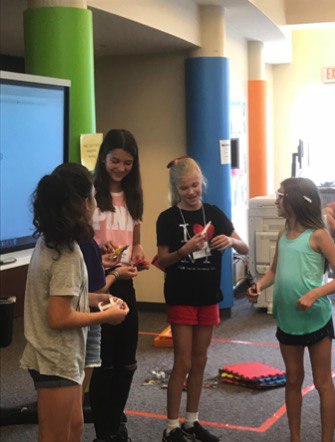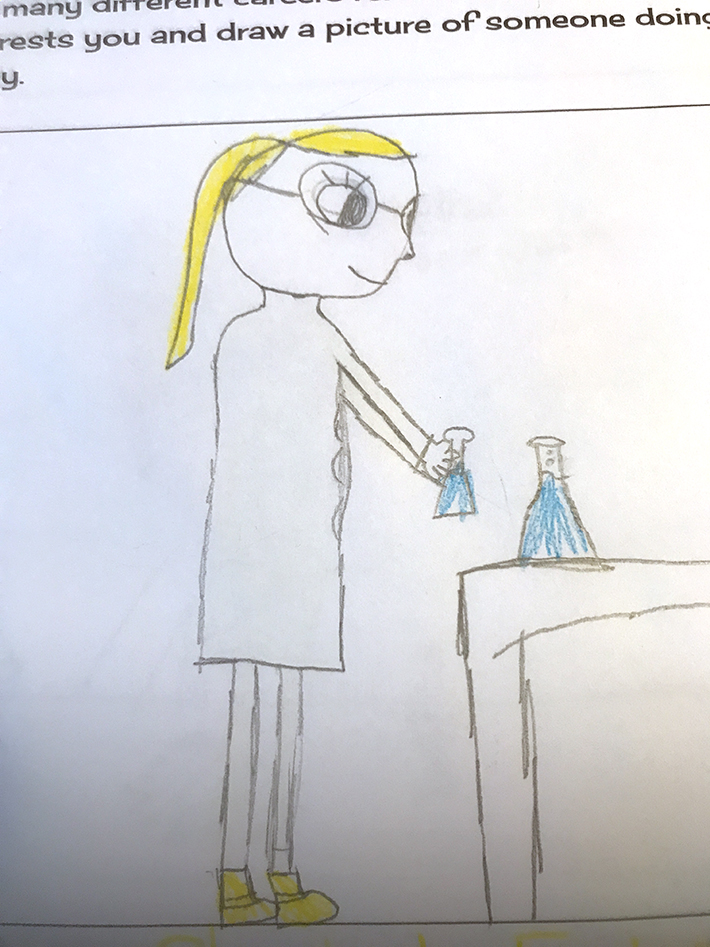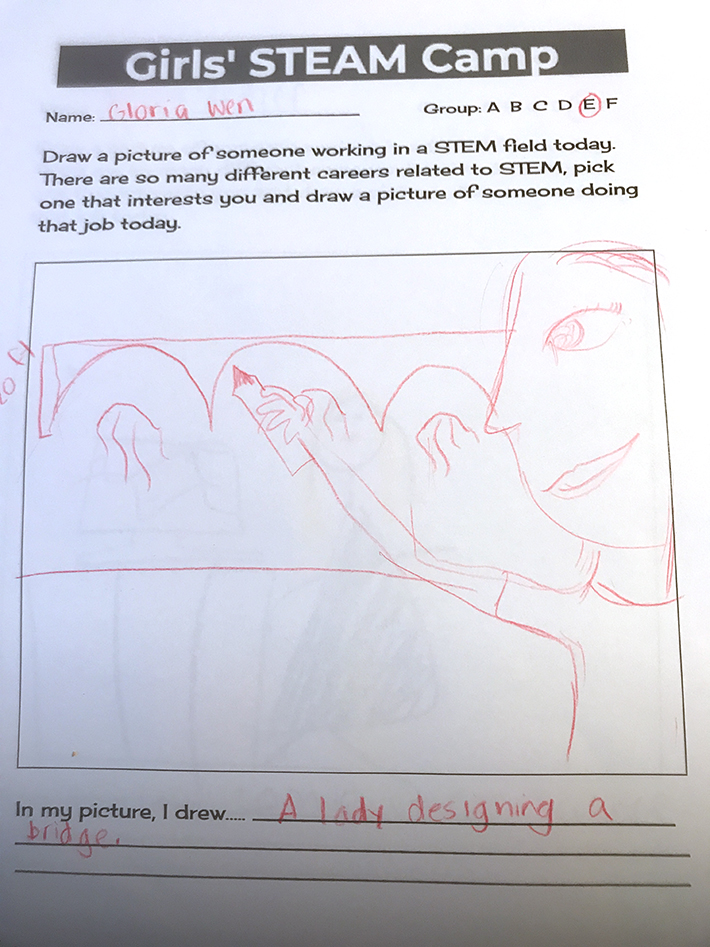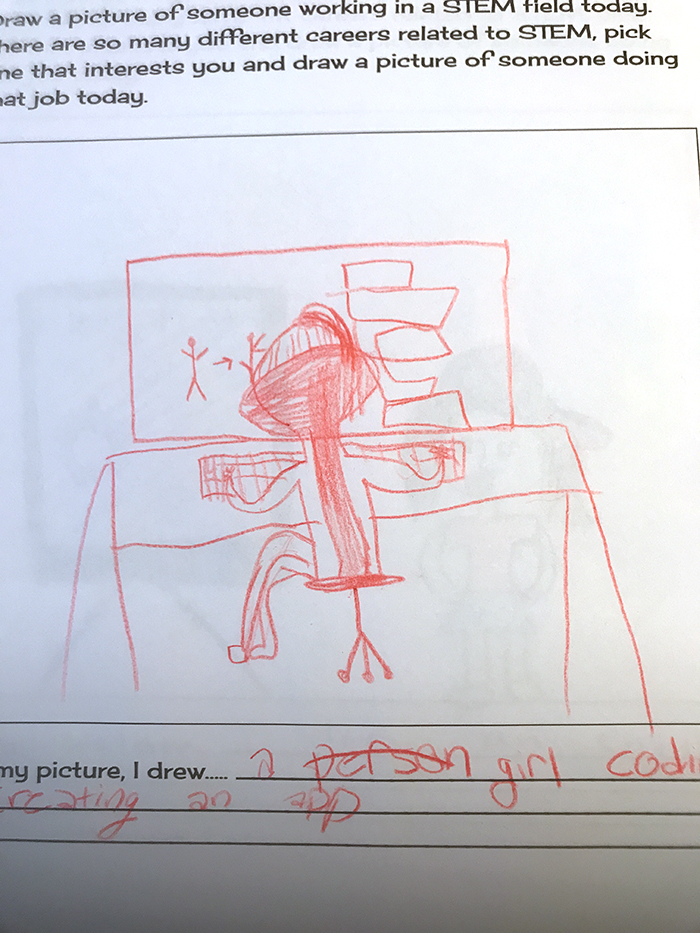Feature
Middle School Girls Gain Confidence, Competence, and Interest Through Summer STEAM Camp
Connected Science Learning January-March 2019 (Volume 1, Issue 9)
By Tamar McPherson, Stephanie Reilly, and Colleen Smith

To combat the well-researched and documented drop in interest and confidence in STEM (science, technology, engineering, and math) that girls tend to experience in their middle school years, the Plum Borough School District, as part of the ABC CREATE Educational Consortium, set out to host a STEAM camp for middle school girls in the summer of 2018 (Kager 2015). The camp was designated as a STEAM camp, to purposefully include an arts component. In Pittsburgh, like in other areas, incorporating the arts is recognized as a potential onramp to STEM for underrepresented students (Jolly 2018).
ABC CREATE is an educational consortium of 14 school districts in the Alle-Kiski region of Pittsburgh, facilitated through Penn State New Kensington. Through ABC CREATE, these school districts are working collaboratively to develop technologically fluent and competent students by expanding STEAM education and access to technology in the region. The collective experience of ABC CREATE partners allowed for many of the technologies used by multiple school districts to be included in the camp program. The Penn State STEM outreach coordinator brought knowledge of research–based practices, as well as experience in hosting girls’ STEAM camps. Four classroom teachers were chosen to lead the camp based on their proven expertise and experience implementing these STEM technologies in their classrooms.
The camp was designed to introduce the girls to two main STEM content areas: making and coding. The making aspects, including using a laser engraver, vinyl cutter, heat press, and 3-D pens, were designed to give the participants confidence in using hands-on technologies. The coding aspects, including writing an app using Javascript and coding in 3-D using CoSpaces, were designed to show the girls that coding is not an out-of-reach challenge, but rather something they can learn and do right now. All of the camp activities were open-ended so that girls could use their artistic design skills and creativity to personalize their projects—no cookie cutter projects with the same end results were used.
In this article, we share our experiences with the camp’s design, implementation, and evaluation to help others support girls’ persistence in the development of STEM skills.
Rationale
The aims of the camp were fourfold:
- to make the camp financially accessible for all girls;
- to make the camp a safe space where girls could explore new technologies and grow their STEM skills, as defined by the “four Cs” of 21st-century learning: critical thinking, communication, collaboration, and creativity;
- to allow the girls to make connections with peers who are also interested in technology; and
- to give girls the interest and confidence to pursue computer science and other technology-based courses in high school and beyond (NEA 2019).
According to Pennsylvania’s Every Student Succeed Act Consolidated Plan (Pennsylvania Department of Education 2018), the state of Pennsylvania currently has 21,000 unfilled computer science jobs. In the next ten years, 71% of new jobs are expected to require computer science skills. With those needs in mind, we placed an emphasis on coding to encourage these middle school students to continue to learn computer programming in high school.
In designing the camp, we relied upon existing research to ensure success and impact. Research-based strategies woven into the camp included exemplary practices highlighted by the National Girls Collaborative Project (NGCP) such as welcoming and educating parents and families; involving female STEM role models; fostering collaborative experiences; and allowing for creative expression, student voice, and choice. Additionally, special attention was given to helping the girls develop friendships, explore new interests, and enhance soft skills such as teamwork and communication. This was accomplished through task design such as having a group problem-solving activity every morning, implementing collaborative tasks to learn the technology, and having the girls speak at our opening and closing meetings.
Program design
Our flyer was designed to entice rising sixth- through ninth-grade girls and assure them that this camp was open to everyone, not only girls who were already experts in coding and other technologies. The camp was led by elementary and high school teachers and the ABC CREATE STEM outreach coordinator from Penn State New Kensington.
Capacity for the camp was capped at the first 60 registrants. The camp was designed to be split into two groups, running simultaneously. Thirty girls per group was deemed to be an appropriate number to ensure that each girl could get the attention and help needed to be successful. Demand for the camp was strong, with several girls placed on a waiting list.
Girls were split into two groups by grade. One group was entirely composed of sixth graders, and the second group was made up of the girls in seventh, eighth, and ninth grade. Each learning session was capped at approximately an hour to keep the participants moving and experiencing both maker and coding aspects every day. The agenda can be found here.
To ensure that no girls faced financial barriers to attending, grant funding was obtained through several different foundations, including the Arconic Foundation, the Grable Foundation, and the National Education Association. Direct donations of snacks and supplies were also obtained from local companies. With this financial support, the registration fee for the four-day camp was only $25. Girls who were eligible to receive free and reduced lunches could have the registration fee waived. The flyer for the camp was distributed primarily to school districts in the Alle-Kiski Valley who were part of the ABC CREATE consortium. The ABC CREATE consortium includes several districts with high percentages of low-income students and several districts that are rural. The camp was purposely held in a location close to these districts to attract participants from a range of socioeconomic backgrounds. Twitter, Facebook, and direct e-mails to school administrators and local teachers were all used to advertise the camp.
All parents and guardians were invited to attend a kickoff session on the first day, as well as an information session on girls in STEM led by Colleen Smith. Through conversations with the approximately 40% of parents and guardians who attended the information session, it became clear that while they fully supported the girls’ involvement in STEM, few recognized the societal and cultural influences that could inhibit these young girls from continuing to pursue the development of STEM skills into high school, college, and careers. Using AAUW’s research report Why So Few? Women in Science, Technology, Engineering, and Mathematics as a guiding reference, the families learned how stereotype threat, gender bias, growth mindset, and self-assessment may influence girls’ persistence in STEM, and discussed strategies for navigating deterrents to girls’ ongoing engagement. Additional research–based resources highlighted for family members included SciGirls Seven, National Center for Women and Information Technology, Techbridge Girls, National Girls Collaborative Project, and effective messaging from the National Academy of Engineering. Many parents and guardians stayed after the information session to share personal stories, ask questions, and solicit additional information.
Messages of the day
Addressing topics such as risk taking, persistence, growth mindset, and inclusive environments was part of our strategic aims in creating a safe place for learning and for building confidence in STEM (Dweck 2016). We started every day of our Girls’ STEAM Camp with the introduction of a Message of the Day, which provided a focus for the girls, instructors, and guest speakers, as well as an opportunity to openly discuss factors that may influence girls’ sustained involvement in STEM.
| Day 1: Be the First Penguin |
| This message is a component of Growth Mindset, which is based on the belief that intelligence and abilities can be developed rather than being fixed (Dweck 2016). We expressed to the girls there may be times when they feel frustrated or overwhelmed or they may fail spectacularly, as we are all at different stages of “yet.” However, they should take everything in stride, find a partner or a group to help them work through obstacles, and know that we are all here to learn from each other. |
| Day 2: The Power of Yet |
| This message was inspired by Pausch and Zaslow’s The Last Lecture (2018), referring to an award that Dr. Pausch would give to his students who took the biggest chance with technology and divergent thinking (Pausch and Zaslow 2018). We wanted to establish that failure is acceptable and a necessary step to learning, especially when what we are learning is new. |
| Day 3: Patience and Persistence |
| By this point in the camp, the girls had been exposed to numerous new technologies and skills. We reiterated that becoming proficient and comfortable with a new skill isn’t instantaneous—it’s a journey. Persistence and patience with oneself are key. |
| Day 4: Be the Kind Kid |
| This message truly captured our goals and vision for the camp. The #BeTheKindKid movement originated at Avonworth School District, a small suburban district of Pittsburgh, where JAM Enterprises, a student-run business of 50 girls in grades K–5, was created in 2015. JAM Enterprises creates, designs, and sells products, then donates the proceeds to charity, using the tagline “Girls who make, girls who care.” Their #BeTheKindKid message has gone viral and t-shirts have been sold worldwide. This movement has inspired opportunities for girls to come together around a project and make something for the greater good. After our morning icebreaker and introducing the Message of the Day, we asked the girls what “Be the Kind Kid” meant to them. Many of the girls spoke about how they had been victims of bullying at their home school, but felt accepted and made friends here at camp. These girls spoke eloquently about the compassion and support they had received throughout the week, especially when they were the only person in attendance from their school district. |
Morning starter activities
In addition to the Message of the Day, each morning involved an icebreaker or group problem-solving activity specifically designed to get the girls talking to each other and build community and camaraderie. The activities were also designed to decrease the stress amongst participants of where to sit and what to do on the first day, as many girls were the only participant from their school.
| Day 1: Get to Know You BINGO |
| After checking in, girls were directed to the cafeteria to find their seats. Each girl’s name was on a Get to Know You BINGO card. Prompts on the cards were designed to start conversation, as girls compared their answers with those around them. Once everyone arrived, the girls circulated to find matches to their answers. This helped set the tone that all are welcome and everyone’s input is valued. |
| Day 2: Caesar Cipher Wheel |
| Girls were challenged to build a Caesar cipher wheel and use it to crack the code on a series of messages. Additionally, they created their own secret messages to share with friends. |
| Day 3: 100 Numbers |
| A 100 number group activity (as described in this blog) was completed to demonstrate the power of teamwork. Given a paper with the numbers from 1 to 100 randomly arranged, groups of four had to race to highlight as many numbers as they could in sequential order. The activity has a low barrier to entry (everyone can find their given numbers), but groups that worked well together by communicating and finding patterns had more success. |
| Day 4: Marshmallow Challenge |
| On the last day, the girls were tasked with building the tallest freestanding structure possible given only 20 strands of spaghetti, a yard of masking tape, a yard of string, and one marshmallow that had to be placed at the top of the structure. This marshmallow challenge is a popular design process and teamwork exercise. See this TED talk and accompanying website for details on how the activity is run. We scheduled this challenge on the last day, when the girls were comfortable taking risks and comfortable working together. The activity was successful in that many different designs were attempted, groups worked together, and girls were proud of their efforts. The challenge also tied together many of the week’s Messages of the Day. |
Guest speakers
Incorporating guest speakers each morning allowed us not only to highlight future STEM careers but also to reinforce our daily messages. Female role models from a variety of fields (including a manufacturing and mechanical engineer, civil engineer, and chemical engineer-turned-patent attorney) shared their stories. The role models stayed to participate in the camp activities and interacted with the girls at an individual level. Two recent female high school graduates were also among our guest speakers. These young women shared their experiences with STEM in high school and gave advice on navigating STEM classes and finding opportunities to progress in STEM, even ones not offered by their high schools.
Maker sessions
In several local school districts and places like the nearby Carnegie Science Center, makerspaces are becoming part of the landscape. Plum Borough has a portable STEAM trailer called the Mobile Maker. It includes a laser engraver, vinyl cutting machine, heat press, 3-D pens, bins of robots and Puzzlets, and a variety of maker supplies.
The first maker task for the girls at the camp was to engrave a wooden name tag. They each chose a font and lanyard to match their personality and learned how the laser engraver on the Mobile Maker worked. After setting up the machine and designing their tag, each girl ran the machine under the supervision of a teacher. The girls proudly wore their name tags all week. The following day, the girls designed and engraved the top of a small wooden box. Their creativity showed: Some girls chose inspirational quotes, while others made designs featuring their names. The key was to create something of their own design using a powerful piece of equipment that is typically relegated to the “woodshop” wing of a school, an area in which girls do not always feel welcome.
Designing the front of their camp t-shirts sparked the girls’ creativity and got them hooked on making. The girls learned about vinyl cutting using a Cricut machine—a cutter available at the local craft store—and a heat press. They were encouraged to use an app called Paint S to either create their own image and text or to remix an image they downloaded from the internet. Some girls chose images from their favorite novels, while other chose images from video games and anime art. The girls were so proud of their designs that they wore their shirts throughout the rest of the week.
Another popular technology in our makerspace were 3-D pens. Using 3-D pens is an effective entry point to using 3-D printers and making designs using CAD software. Initially, the girls were given templates from which to trace and build. Soon after using the first template, the girls began making their own creations, which included silly eyeglasses and multicolored flowers. Some of the creations were multilayered and intricate.
Through the introduction of Hummingbird Robots, we bridged the maker movement with robotics and coding. Hummingbird Robots are Arduino boards with quick-connect wire terminals. These robots come with LEDs, various motors, and several different sensors. The board connects to a computer via a USB cable and uses programming languages such as Scratch, Python, Java, and Arduino. Using the board, LEDs, motors, and sensors, Hummingbird Robots allow anyone to create dynamic works of art and engineering to tell a story. The girls learned the basics of how to make the LEDs light up and make gears and servo motors turn. They then created animals, vehicles, and dioramas with upcycled materials and craft supplies. They attached LEDs and motors to make the wheels on a car turn, the tail of a dog wag, and stars twinkle in the sky. Here is an example of a Hummingbird Robot creation using servo motors and LEDs.
For all of the maker activities, girls were supervised and assisted by several teachers, as well as five high school students. The high school students were volunteers from Plum Senior High School, all girls, and all interested in mentoring younger girls in STEM. These students were trained on all of the equipment, including safety precautions.
Coding sessions
One of the programming experiences we offered was the opportunity for girls to create their own apps. An app is a code that runs on a phone, which can easily be customized and personalized. We used the code.org website and their App Lab coding environment. App Lab allows drag and drop coding in Javascript, thus lowering the entry point for coding. With drag and drop coding, the commands are simply dragged into the workspace and the details of syntax are handled internally by the coding environment.
The first coding session was an interactive tutorial, which resulted in each participant creating a simple app. The second session gave the girls full control of designing their own app. Girls could choose to either work with a partner or work independently. Some made a “choose your own adventure” game, complete with sounds and images. Others made an “All About Me” app with pictures of their families, friends, and favorite hobbies. Several girls made quiz apps, including personality quizzes and quizzes that test the user’s knowledge. Here is an example of what they created after only two hour-long sessions with code.org’s App Lab.
All of the coding sessions were run by two high school teachers with extensive experience teaching coding, assisted by two high school students who are experienced in coding as well. The high school students worked through the App Lab activity prior to the camp as preparation for helping girls with coding issues. Girls were quick to seek help from either the teachers or the student assistants if they got stuck. In such instances, girls were encouraged to try pair programming, a well-researched best practice in computer science education in which two students work together on a code to avoid frustration and encourage talking through the coding (Mentz and Bailey 2017).
The power of code.org’s App Lab is not only the ease with which students can build their first app, but also the ease with which they can share their creation. With a simple click of the “Share” button, one can enter a cell phone number and share their app with friends and family. As girls walked out of their second app building session, they were huddled over their phones, excitedly sharing creations with each other.
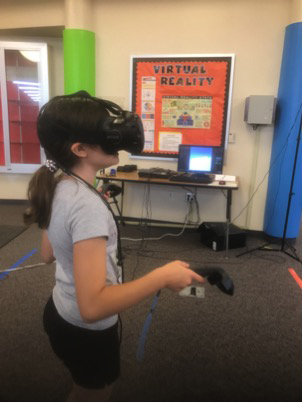
A significant portion of the camp was spent on virtual reality (VR). The girls used Oculus Rift and HTC Vive to experience the amazing technology of high-end VR. They were able to virtually repair the International Space Station, fly around Paris or anywhere else on the globe using Google Earth, experience parachuting into D-Day as a WWII soldier, and create works of art by manipulating light using the Tilt Brush VR app. Even virtually riding a roller coaster and having your stomach drop at the bends and hills, while your brain knows that you are standing still, is a learning experience about the sensory dissonance that VR can elicit (Slater, Steed, and Usoh 1995).
We wanted the girls to go beyond experiencing virtual reality and also create something. CoSpaces is an app that allows students to create a scene and then code the assets to move and interact. The whole scene can then be viewed with VR headsets for an immersive experience, all created by the camper.
Similar to the two App Lab sessions, the first VR session was designed as an introductory tutorial. However, since CoSpaces is user friendly and engaging, the girls immediately jumped in and starting building their scenes, with guidance from teachers, student assistants, and each other. See a sample of campers’ creations in CoSpaces here.
To incorporate computational thinking and coding in as many different ways as possible, we also introduced girls to flying and programming drones. We gave each group several foot-long sections of PVC pipe and four-foot sections of foam pool noodles, duct tape, some PVC pipe connectors, a drone, and an iPad. Instructions were simply to design and build an obstacle course, then program the drone to fly through it. Programming the drone was done using Tynker, a drag and drop programming app that works with Mambo drones.
We had an initial idea of how the groups would design their obstacle course, and not one group built it the way that we envisioned. The girls’ obstacle courses were more creative, as you can see from the pictures below.
Hackathon
The culmination, and highlight of the week, was the “hackathon” on the final day of camp. A hackathon is an event that can last anywhere from 24 hours to several days, involving intense collaborative computer programming. We adapted that model for the Girls’ STEAM Camp by giving the girls a total of three hours to dive back into one of the technologies they learned to create something. They had the option to work in a group or alone, and could either start a new project or dive deeper into a project they had already started. We encouraged the girls to be bold and to be the “First Penguin,” connecting back to Randy Pausch’s message from The Last Lecture (Pausch and Zaslow 2018). Some even chose to teach themselves a new technology (Tinkercad or Paint S software, for example).
At the end of the hackathon, the entire camp gathered to share their creations, and parents were invited to watch the presentations. The coders ran their codes on a large Smartboard in the library for everyone to see, while other groups showed off the items they made by 3-D printing or using the vinyl cutter. Still other groups shared their robots made using Hummingbird kits. The excitement was evident in each girl’s presentation. They were proud of themselves for creating something using new technology, and they had the confidence to share their creations in front of their peers.
Evaluation
We ended each day with a reflection activity in the form of an exit pass that tied into the message of the day and enabled the girls to express their thoughts about the camp. On the third day, the exit pass asked them to draw a picture of someone working in a STEM field today. The question was purposefully open-ended, to see what the girls pictured when they envisioned a STEM-related job. After three days of Girls’ STEAM Camp, almost every girl drew an obviously female employee doing something with technology or science. Here are a few examples:
The survey responses from the last day indicated successful achievement of the camp’s three educational goals: providing a safe environment, allowing girls to explore technology and develop STEM skills, and giving the participants the confidence to pursue computer science and other technology-based courses in high school and beyond. The campers’ responses to questions ranking their interest and confidence in learning new technologies averaged at or above 4, on a 5-point numerical scale in which 1 = “Not confident at all” and 5 = “Very confident.” Ninety-two percent of respondents to the open-ended question “Because of attending this ABC CREATE@Plum Girls’ STEAM Camp, I am more …” completed the prompt with a phrase that included words such as “interested,” “confident,” “aware,” “excited,” “comfortable,” and “knowledgeable.” In response to a question about their likelihood of taking a computer science course in high school, with choices of:
- “No way,”
- “I’m not sure yet,”
- “I might,”
- “I probably will,” and
- “Definitely, I can’t wait!”
Only one girl selected “No way” and 11 girls selected “I’m not sure.” The rest of the camp participants selected choices reflecting their openness to or confidence in taking a high school computer science course.
We were surprised by the unsolicited and positive feedback we received from parents through e-mails, texts, and phone calls. Parents let us know what a positive experience the camp was for their daughters, which provided further evidence that the camp met its targeted goal. The testimony from both girls and their families assured us that the participants had been given a solid opportunity to experience new technologies in a nonthreatening environment, made friends with others who share their interests, and increased their confidence with and their knowledge of technologies. Local press coverage (article and video), featuring the girls at work, was overwhelmingly positive.
Lessons learned
Planning for next year’s camp has already begun. Changes we will make include the following:
- Upgrading the t-shirt design process to include more extensive use of Paint S software, so that girls are creating their designs instead of finding images online, and purchasing a full-color t-shirt transfer printer so that girl-created designs can be easily printed and pressed.
- More training on drone flying before handing over the equipment, to avoid breakage.
- More structure in the use of the 3-D pens to include design challenges.
- Formally inviting parents to attend hackathon presentations.
We consider the camp to have been a success at achieving our four primary goals, based on the qualitative and quantitative feedback from the girls and their families. Further, we attribute its success to understanding and applying the well-researched strategies for engaging girls in STEM outlined at the beginning of this article, as well as to the collaborative approach to planning and implementing the four-day STEAM camp. We are grateful for the existing research that guides the work of impacting girls’ sustained involvement with STEM, and we are pleased to put those practices in action to support and encourage girls within our sphere of influence.
Tamar McPherson (mcphersont@pbsd.net) is math and computer science teacher at Plum Senior High School in Plum, Pennsylvania. Stephanie Reilly (stephanie_reilly@fcasd.edu) is online learning coordinator in Fox Chapel Area School District in Fox Chapel, Pennsylvania. Colleen Smith (cms64@psu.edu) is STE(A)M outreach coordinator at Penn State University, New Kensington Campus, in New Kensington, Pennsylvania.
STEM Middle School Informal Education



